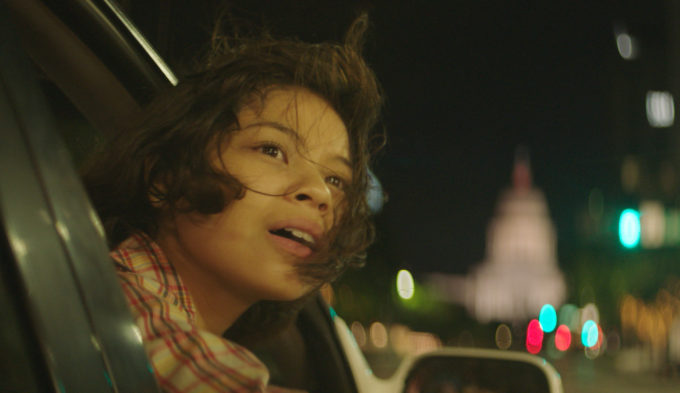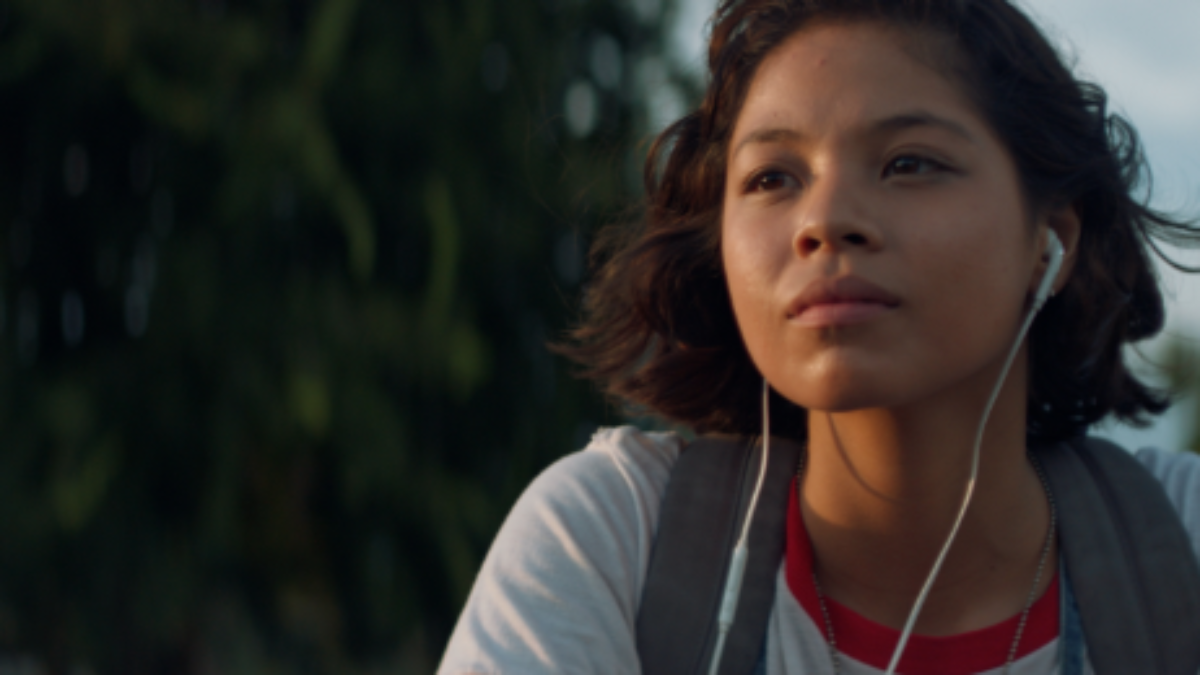Written By: Melissa Slaughter

“Square peg, round hole. I run away with nowhere to go.”
Eva Noblezada croons this line in varying degrees during the course of her starring turn in the film Yellow Rose. The 23-year-old is already a two-time Tony Award-nominated actress, thanks to her Broadway performances in Miss Saigon and Hadestown. But Yellow Rose marks her feature film debut.
“Eva brought so much to the film,” writer/director/producer Diane Paragas told me. “She has an incredible energy and the camera just loves her. She is one of those actresses that is so natural in front of the camera and instinctively knows how to give just enough … Even though Eva is still in her early 20s, she’s been through a lot and that vulnerability was really acting.”
That vulnerability is unmistakable in this story that runs the gamut of emotions. Rose (played by Noblezada) is an undocumented Filipino teenager living in a small Texas town with her mother. She dreams of being a country music star, but instead is going to school and cleaning hotels. One day, ICE agents pick up her mother and detain her. Rose is left alone to fend for herself.
Diane Paragas has had this story in her heart for quite some time: “I started writing Yellow Rose over 15 years ago. I think I wanted to write a story about my own experience as a Filipina-American growing up in Texas … Of course when you write a story as personal as this one, you can’t help to infuse some of your own personality into the character. I’m definitely a fighter and, of course, I wrote music all the time when I was the age of Rose in the film. I even had a band and I think music (and painting) were my outlets for feeling like an outsider.”
“Square peg. Round hole.”
The lyrics resonate throughout the film. Rose is an anomaly in her town; Paragas felt the same. It’s an isolating feeling, being outside the norm. And Paragas perfectly captures that sensation, whether it’s in the long lingering shots of wheat fields, or in the choices Rose must make to survive. As the viewer, I saw my own childhood resonating back to me. I grew up on in a small, rural, conservative town in Oklahoma, where there were only a handful of Asian Americans. Like Rose, I also dabbled in music and the arts. Like Paragas, who “didn’t really have a relationship with country music at all,” I wasn’t too into the country music scene that dominated my high school.
When I was growing up in Oklahoma, there were also very few Asian faces I could see on-screen. It’s a shared experience for many people of Asian-descent living in the U.S. For Paragas, the first time she saw herself reflected on-screen was “probably The Debut by Gene Cahayan [starring Dante Basco]. But that was 18 years ago, and I have to say I have rarely had that experience again since then.” In Yellow Rose, Paragas populates the film with familiar Filipina faces: Lea Salonga and Princess Punzalan.
“I have been extremely lucky to have these iconic actresses put their trust in me for the film. But I think there is such a hunger for authentic Filipino films, they were rooting for me from the beginning. They were both a dream to work with.” Salonga, who plays Rose’s Tita Gail, is perhaps most well-known for lending her singing voice to Princess Jasmine and Mulan in Disney’s Aladdin and Mulan. Princess Punzalan (Rose’s mother, Priscilla) might not be known to American audiences, but in the Philippines she has starred in numerous TV shows and films. Diane told me “Princess has been on this project for years and did many chemistry reads when we were auditioning for Rose.”
So how did this independent film, with such an outstanding cast, become a festival favorite? With the help of community organizers and supporters, like Asian CineVision (ACV). (Yellow Rose is the opening night presentation for the Asian American International Film Festival, ACV’s annual hallmark event). Paragas told me that “I have had the great fortune of having Asian Cinevision as our fiscal sponsor for over 7 years well before we even did our short film. Having that kind of community support early on kept us going through those first years of getting the project off the ground.” In addition to Asian CineVision, Cinematografo and ABS-CBN co-produced the project. Their goal is to highlight and promote Filipino voices in cinema.
Paragas is able to create different types of Filipina characters. She also is able to create a story that is rarely reported or seen: the detainment and deportation of Filipino and Asian immigrants.
“I run away with nowhere to go.”
“We definitely put more of a focus on the role of the mother going through the ICE arrest and deportation process and to show the detention centers after Trump came into office,” Paragas said. “I think most people, when they think of ICE raids, they think of the Mexican border. But Filipinos are the third largest immigrant group in the US, and again we are virtually invisible in any kind of film or television. And of course that goes for the immigration experience as well.”
Immigration and Customs Enforcement has been raiding homes and businesses across the U.S. more forcefully since 2016 when President Trump took office. While Asians are barely considered in the discussion of deportation, there’s no doubt that it’s affected the community. Rose comes face to face with ICE agents more than once in the movie. And each time the pressure is palpable. Paragas also made it a point to show people who work within the system. There’s the immigration lawyer who comes to Rose’s aid. The administrator assigned to her mother’s case treats her with respect and understanding. Even a guard is given a moment of compassion. “I didn’t want to demonize ICE as this monolithic entity either.”
Rose’s day-to-day life is constantly changing. Should she wait for DACA to be renewed? Return to Manila with her mom? Stay with her Tita Gail whose husband isn’t too keen on helping her niece? Or does she strike out her own?
With so many uncertainties in Rose’s life, one thing remains the same. To say it’s the healing power of music would be a wild cliche, but it wouldn’t be far from the truth. Music permeates this movie, keeping it light. The trauma of her mother’s detainment is balanced by the music that keeps her afloat. Paragas perfectly balances the two for the audience. The music keeps the film from being mired in the drama of it all, never letting the film drop into anguishing tragedy.
Paragas described Rose as “an old soul. The classic brand of country music appeals to her. She’s a throwback and a romantic so the songs of Townes and Willie speak to her.” This is the heartbeat of the fim, the soft pulse of country music that lives outside the mainstream. Despite the lack of Asian American country stars, Rose fits into the honky tonk music scene like a fish in water.
A major inspiration for the music in Yellow Rose came from musician Dale Watson. Watson is best known for a style called “Ameripolitan,” a genre of contemporary country that encompasses traditional styles like Western swing, outlaw, and rockabilly. Watson’s songs are heavily featured. He even wrote some songs for the film, as did Paragas and Thia Megia (who starred in the short for Yellow Rose). The music is catchy, vulnerable, and sung by Noblezada with vivacity and power.
Yellow Rose is one of the best films I’ve seen this summer. It’s beautifully shot and wonderfully acted. The story is both timely and still timeless. Rose’s circumstances might be a response to the urgency of today’s political climate. But her efforts to find her identity and her true home is a universal theme that will resonate through the ages.
Yellow Rose
buy tickets*
Thursday, July 25, 2019 7:00 pm
Asia Society
Director: Diane Paragas
Stars: Eva Noblezada, Lea Salonga, Dale Watson, PRincess Punzalan, Liam Booth, Gustavo Gomez
Running Time: 1 hour 34 minutes
Genre: Narrative
*This event is sold out

